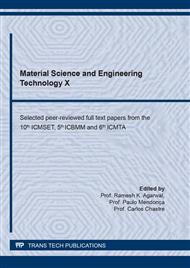[1]
Parepalli, Yugandhar, Sudhakar Pamanji, and Murthy CHAVALI. 2014. An overview of Smart Materials in Nanoscience and Nanotechnology., International Journal of Nanoscience & Technology 3: 9-14.
Google Scholar
[2]
Ulaeto, Sarah, Ramya Rajan, Jerin Pancrecious, T.P.D. Rajan, and Chandrasekhar Pai. 2017. Developments in smart anticorrosive coatings with multifunctional characteristics., Progress in Organic Coatings 111: 294-314.
DOI: 10.1016/j.porgcoat.2017.06.013
Google Scholar
[3]
Baghdachi, Jamil. 2009. Snart Coatings., ACS Symposium Series 1002: 3-24.
Google Scholar
[4]
Nagappan S., Moorthy M.S., Rao K.M., Ha CS. (2016) Stimuli-Responsive Smart Polymeric Coatings: An Overview. In: Hosseini M., Makhlouf A. (eds) Industrial Applications for Intelligent Polymers and Coatings. Springer, Cham. https://doi.org/10.1007/978-3-319-26893-4_2.
DOI: 10.1007/978-3-319-26893-4_2
Google Scholar
[5]
Ko, C.U., E. Balcells, T.C. Ward, and J.P. Wightman. 1989. Effect of Surface Topography on the Relaxation Behavior of Thin Polysulfone Coatings on Pretreated Aluminum Substrates., The Journal Of Adhesion (Taylor & Francis) 28: 246-260.
DOI: 10.1080/00218468908030173
Google Scholar
[6]
Yuan, Peng, Peter Southon, Zongwen Liu, Malcolm Green, James Hook, Sarah Antill, Cameron Kepert, Sarah, and Antill J. 2008. Functionalization of Halloysite Clay Nanotubes by Grafting with γ-Aminopropyltriethoxysilane., The Journal of Physical Chemistry C 112: 15742-15751.
DOI: 10.1021/jp805657t
Google Scholar
[7]
Kamble, R., M. Ghag, S. Gaikawad, and Bijoy Panda. 2012. Halloysite Nanotubes and Applications: A Review Ravindra Kamble., J. Adv. Sci. Res. 3.
Google Scholar
[8]
Abdullayev, Elshad, Vagif Abbasov, Asel Tursunbayeva, Vasily Portnov, Hikmat Ibrahimov, and Gulbaniz Mukhtarova. 2013. Self-Healing Coatings Based on Halloysite Clay Polymer Composites for Protection of Copper Alloys., ACS applied materials & interfaces 5.
DOI: 10.1021/am400936m
Google Scholar
[9]
Khairina Azmi Zahidah, Saeid Kakooei, Mokhtar Che Ismail, Hamed Mohebbi, Ali Hassani Joshaghani, Mostafa Ghasemi, Kee Kok Eng. 2019. Smart anticorrosive coatings containing corrosion inhibitor–loaded halloysite nanotubes., 425-447.
DOI: 10.1016/b978-0-12-815884-5.00013-2
Google Scholar
[10]
Chowdhury, Reaz, Mahesh Hosur, Md. Nuruddin, Alfred Tcherbi-Narteh, Ashok Kumar, Veera Boddu, and Shaik Jeelani. 2015. Self-healing epoxy composites: preparation, characterization and healing performance., Journal of Materials Research and Technology 4 (1): 33-43.
DOI: 10.1016/j.jmrt.2014.10.016
Google Scholar
[11]
Safaei, Fariba, Saied Nouri Khorasani, Hadi Rahnama, Rasoul Esmaeely Neisiany, and Mohammad Sadegh Koochaki. 2018. Single microcapsules containing epoxy healing agent used for development in the fabrication of cost efficient self-healing epoxy coating., Progress in Organic Coatings 114: 40-46.
DOI: 10.1016/j.porgcoat.2017.09.019
Google Scholar
[12]
Massingill, J.L., and R.S. JR. Bauer. 2000. EPOXY RESINS., In Applied Polymer Science: 21st Century, 393-424.
DOI: 10.1016/b978-008043417-9/50023-4
Google Scholar
[13]
Saif, Muhammad, Hafiz Asif, and Muhammad Saeed. 2018. Properties and modification methods of halloysite nanotubes: A state-of-The-art review., Journal of the Chilean Chemical Society 63: 4109-4125.
DOI: 10.4067/s0717-97072018000304109
Google Scholar
[14]
Saleh, Najat, Adnan Abdulzarak, Manal Tooma, and Mariam Aziz. 2011. A Study Mechanical Properties of Epoxy Resin Cured at Constant Curing Time and Temperature with Different Hardeners., Eng Tech J.
Google Scholar
[15]
Yüce, Elif, E. H. Mert, S. Şen, S. Saygı and Nevim San. Properties and applications of nanoclay reinforced open‐porous polymer composites., Journal of Applied Polymer Science 134 (2017): 45522.
DOI: 10.1002/app.45522
Google Scholar


